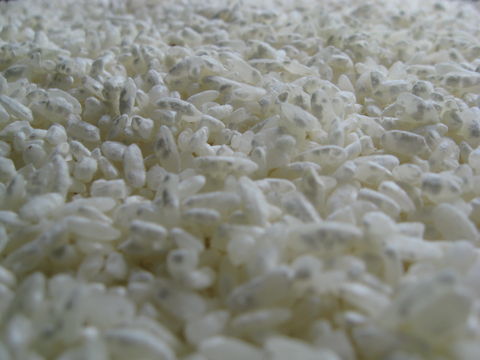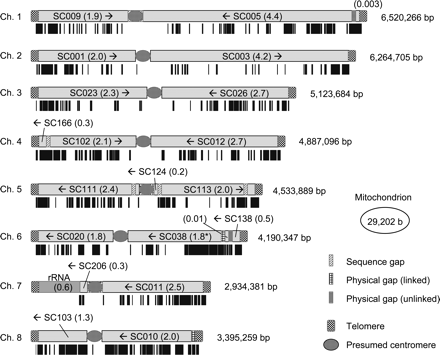Aspergillus oryzae: Difference between revisions
No edit summary |
No edit summary |
||
| Line 3: | Line 3: | ||
<i>[[Aspergillus]] oryzae</i> is a mold used in the food production, such as [[soybean]] fermentation. | <i>[[Aspergillus]] oryzae</i> is a mold used in the food production, such as [[soybean]] fermentation. | ||
[[File:a.oryzae rice.jpg|500px|thumb|right|<i>A. oryzae</i> | [[File:a.oryzae rice.jpg|500px|thumb|right|<i>A. oryzae</i> shown here growing on grains of rice.]] | ||
==Classification== | ==Classification== | ||
Revision as of 01:24, 30 April 2015
Aspergillus oryzae is a mold used in the food production, such as soybean fermentation.
Classification
Domain - Eukarya
Phylum - Fungi
Class - Eurotiomycetes
Order - Eurotiales
Family - Tricocomaceae
|
NCBI: A. oryzae Taxonomy |
Aspergillus oryzae
Genome
The entire genome of A. oryzae contains eight chromosomes and is 37.6μb in size.[1] In comparison with the two other Aperigilli, A. oryzae is 25-30 percent larger in its genome, and has 2000-3000 more genes than the other two species A. nidulans and A. fumigates [2]. A. oryzae is linear. Describe the size and content of the genome. How many chromosomes? Circular or linear? Other interesting features? What is known about its sequence?
Cell Structure, Metabolism and Life Cycle
Interesting features of cell structure; how it gains energy; what important molecules it produces. When A. Oryzae comes in contact with energy sources, it secretes enzymes capable of converting complex organic molecules to simpler ones Many of the extra genes present in A. oryzae are predicted to be involved in secondary metabolism. It is asexual
Ecology and Pathogenesis
Habitat; symbiosis; biogeochemical significance; contributions to environment.
If relevant, how does this organism cause disease? Human, animal, plant hosts? Virulence factors, as well as patient symptoms.
The habitat that the A. oryzae live in are oxygen rich environments. It is highly aerobic and grow as molds on the surface of a substrate. They are contaminants of starchy foods such as bread and potatoes and may grow on plants and or trees as well. Members of its genus can also be used for medications that treat diseases.
Significance and Application
Aspergillus oryzae has apparently been an essential part of oriental food production for centuries and is now used in the production of many different oriental foods such as soy sauce, sake and miso[4]
The A. oryzae strain sequenced is RIB40 [15], which was isolated in 1950 and exhibits morphological, growth and enzyme production characteristics typical of those in industrial (patented) strains used for sake brewing[5]
References
[1] Machida, M., Yamada O., and Gomi K. "Genomics of Aspergillus oryzae: Learning from the History of Koji Mold and Exploration of Its Future." Oxford Journals: DNA Research. Volume 15(4). p. 173-183
[2] http://dnaresearch.oxfordjournals.org/content/15/4/173.full
[3] Machida M., Asai K., Sano M., Tanaka T., Kumagai T., Terai G., Kusumoto K., Arima T., Akita O., Kashiwagi Y., Abe K., Gomi K., Horiuchi H., Kitamoto K., Kobayashi T., Takeuchi M., Denning D. W., Galagan J. E., Nierman W. C., Yu J., Archer D. B., Bennett J. W., Bhatnagar D., Cleveland T. E., Fedorova N. D., Gotoh O., Horikawa H., Hosoyama A., Ichinomiya M., Igarashi R., Iwashita K., Juvvadi P. R., Kato M., Kato Y., Kin T., Kokubun A., Maeda H., Maeyama N., Maruyama J., Nagasaki H., Nakajima T., Oda K., Okada K., Paulsen I., Sakamoto K., Sawano T., Takahashi M., Takase K., Terabayashi Y., Wortman J. R., Yamada O., Yamagata Y., Anazawa H., Hata Y., Koide Y., Komori T., Koyama Y., Minetoki T., Suharnan S., Tanaka A., Isono K., Kuhara S., Ogasawara N., Kikuchi H. Genome sequencing and analysis of Aspergillus oryzae. Nature 2005. Volume 438. p.1157-1161.
[4]http://www.epa.gov/biotech_rule/pubs/fra/fra007.htm
[5]http://www.sciencedirect.com/science/article/pii/S0168952508003120
Author(s)
Page authored by Hannah Nanavaty and Matt Ogledzinski, students of Prof. Jay Lennon at Indiana University.


